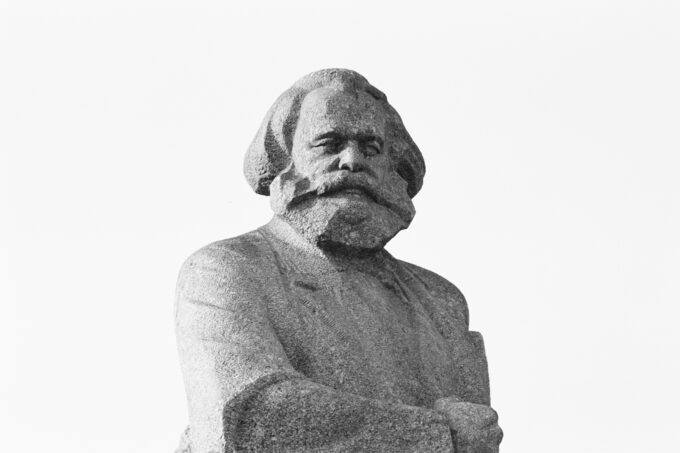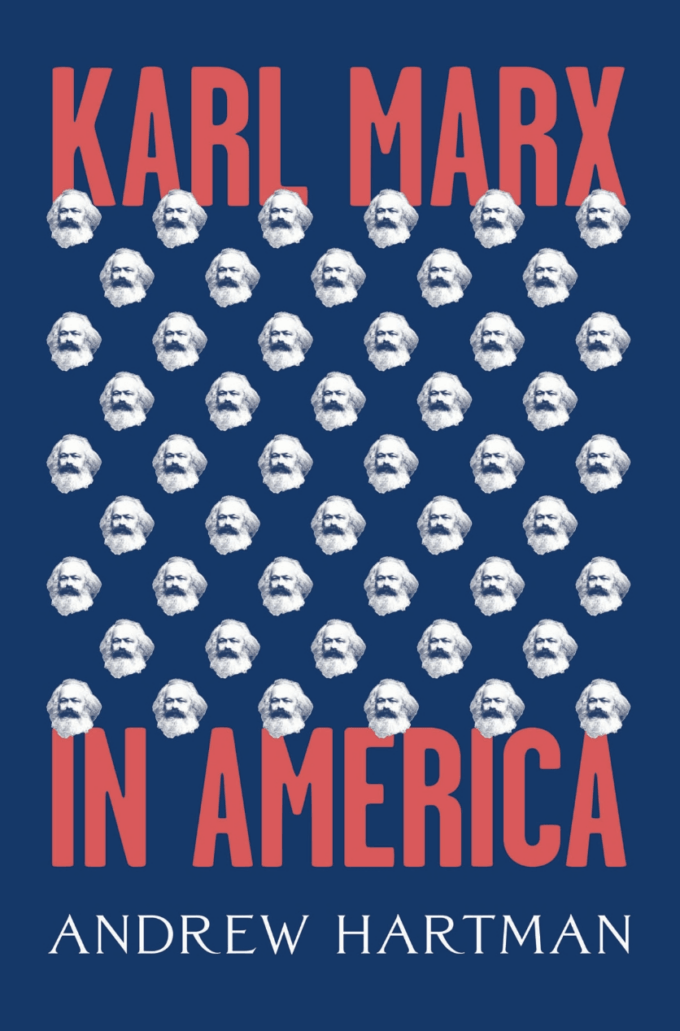
Image by Hennie Stander.
Andrew Hartman, Karl Marx in America. Chicago: University of Chicago Press, 2025. 572pp, $39.00
Back in the 1890s, when American Marxism was young, some socialist intellectuals in the US had already begun to complain that the American Left just did not understand what Marx had written. Louis B. Boudin (still called “Budynov”), later to write a noted defense of Capital and still later a three volume history of American law, must have stunned Yiddish readers of the Tsukunft (“the future”) with his claims made in strident tones. Or not: in the midst of the 1890s literary conflict between Yiddish anarchist and Marxist publications in the Lower East Side, everybody seemed to enjoy a good scrap.
If the US, the most industrially advanced nation, nevertheless lacked a working class grasping for Marxist ideas and socialist transformation, something had to be wrong, but what was it? Andrew Hartman has written a very large and interesting book full of people and ideas, very much within this framework, making choices sometimes inevitable to the subject, sometimes bewildering to this reviewer. It is not necessarily a criticism of this reviewer—the author of Marxism in the US and co-editor of the Encyclopedia of the American Left—to remark that I have seen (and lived within) a different American Marxism. I hope the reader will indulge me as I describe this other Marxism a bit, along the way.
Non-US anti-Marxists whose ideas have arrived, stayed, departed or not among steadfast conservatives and repentant former Marxists alike, find a place in Karl Marx in America, but many Americans writing about Marx or attracted to Marx seem oddly missing here. The author of The Theoretical System of Karl Marx—so admired at the time that even the Germans produced their own translation—Boudin would be among the prominently missing. Likewise, on the other side of the fence, the late Hoover Institute savant, Bertram D. Wolfe, whose insightful Marx and America (1934) made a splash in his days when his group, the Lovestoneites, had not yet defected to CIA-financed activities in the global labor movement. 
Boudin’sand Wolfe’s successors have, at any rate, been at it ever since and even continue today, with a familiar conclusion: if only Americans had REALLY understood Marx, the history of the Left would surely have been very different.Neither Boudin, Wolfe nor a score of other Marx-pondering writers admiredin their own time appear in Hartman’s research, yet their intended point seems to hang in the air throughout the book.
With deep sincerity and what is obviously his own chosen chunk of this story, Hartman adds to it a larger context, twice over: Marx’s role in the US via his own writings, and secondly, the various ways that notable non-socialist, including anti-socialist, mostly hawkish Cold War intellectuals have understood or misunderstood him. He has a lot to say. I regret that he stays within this mainstream, notably leaving aside the voices of ethnic, that is to say, immigrant socialist intellectuals, very often the ones with the largest working class audience.
How the readers of the German-American press admired the Marxist expositions of Herman Schlüter, long-time editor of the daily New Yorker Volkszeitung, in his newspaper and a book or two (including the first history of the Marxist socialist movement in the US, Die Erste Internationale in America)! And how the Yiddish readers of the Morgan Frayhayt, voice of the Yiddish Left, loved to read the Marxist writings of Paul (Pesach) Novick, who lasted long enough for me to visit him, still hard at work in the newspaper office, at age 91. These, and their many counterparts among Slavs, Hungarians, Finns and others were truly Marxists On the Job, their communities and cultural clubhouses places where working people talked about Marxism and the conditions of their own lives.
Hartman touches heavily upon radical celebrities like John Reed, an admitted intellectual lightweight whose reportage and personal example nevertheless stand the test of time. So many literary celebrities, in particular, that his list seem to becomes more arbitrary. Thus journalist-novelist Vivian Gornick along with CPUSA heavy William Z. Foster, and even Hungarian-American artist Hugo Gellert, who I was lucky enough to interview in his advanced age. Small joke: among Gellert’s stellar, presumably Marxist-influenced comrades in the Hungarian-American Left of the 1920s-40s, Bela Bartok and Bela Lugosi, do not appear here. I am only having a little fun with the categories. Marilyn Monroe and Lucille Ball really were also attracted to socialist ideas and…I leave my own, further celebrity-left list here, reluctantly.
Hartman gives sufficient credit to the early Sidney Hook (among the first to draw conclusions from Marx’s “Economic-Philosophical Manuscripts,” published in German) and too much to popularizers like Reinhold Niebuhr, who, like Hook, turned hard right. His judgment of the Popular Front writers (he rightly includes F.O. Matthiesson) misses the most influential ones: screenwriters whose Wartime features sought to encompass Marx’s legacy within hopes for democracy or (after 1946) the very noir reality of postwar life in a troubled consumer society.
Were their Popular Front-shaped, occasionally Oscar-winning films less successful in delving the American democratic saga than Matthiesson? And what about the hidden scriptwriters of television’s “You Are There?” and “The Adventures of Robin Hood?” Marxists, all. If Hartman could be magically transferred to the Marxist study classes of Hollywood of the late 1930s and early 1940s, he would surely be surprised. And illuminated enough to ask whether the popular culture activists and creators on the Left, right down to Zero Mostel, Harry Belafonte and Tony Kushner, were not the real (crypto) Marxists.
But this is, after all, a book about book (and essay) writers grown prestigious enough to have their comments on Marxism taken seriously in the prestige press. Thus we find Edmund Wilson, Max Eastman, Dwight Macdonald, Daniel Bell and among many others, including some of the worst Cold War hacks, like the very shallow Clinton Rossiter.
It is striking that Hartman comes across the unpublished (in his lifetime) book length essay by CLR James, “American Civilization,” c.1950, really the outline of a book that James would not complete, thanks largely to awaiting expulsion on a passport violation decades earlier. Notwithstanding real insights, notwithstanding my almost fan-like admiration of him (as his authorized biographer), James missed important details about the American world around him. He would have been shocked, perhaps even horrified, to learn that so many of his favorite films and radio shows—in his view reflecting the truly democratic ethos of ordinary Americans—had been written by the dreaded “Stalinists” of Popular Front circles, themselves already in 1950 going on the Blacklist at the same time a James was being expelled. A keen thinker but short-time resident of the US, 1938-50, James badly misunderstood what had been made of Marx’s legacies.
More oddly, for me, Hartman seems to go into high gear with the Cold War. Whittaker Chambers, destined (perhaps) for a statue on the White House patio, spoke for a legion of others: they had learned the error of the youthful ways, and made a grand career of it, details be damned. For conservatives then and now, Marx was the prophet of an evil religion, expunging the deity for the false promise of an unattainable (and undesirable) levelling of human inequalities.
I am not so pleased that important Marxist literary scholars like Alan Wald are swept aside, but happy to see that Angela Davis gets some serious treatment as a creative thinker. I do not grasp what the great reactionary Polish liberal, Leszak Kolakowsky, is doing here at all, as I had never grasped why Straussian economics found a place earlier in the book. Karl Marx’s America increasingly slips into global debates about Marxism in the Cold War era, when the pages might better have been spent on the rethinking of Marxist tenets for instance, as inventive socialists viewed the Cuban Revolution, the rise and assasination of Malcolm X, the Vietnam War, the great and continuing debate about Zionism among Jewish Marxists and others, and so on. And if Leslie Silko’s very fine novels come into a study of Marx’s impact, where do we find other novelists, poets and filmmakers who were equally touched and moved?
Hartman does not finally come to terms with the contradiction in Werner Sombart’s famous argument, offered around the turn of the twentieth century, that the sheer prosperity (“roast beef”) of the American working class made a successful socialist movement impossible. The sharpest division of best-paid and worst-paid workers in the world, the racial hierarchy, the geographical mobility and lack of historical roots that gave European socialists a basis for a movement….none of these, nor the fact of an expanding US empire, seemed to have reached Sombart’s consciousness as keys to the supposed contradiction.
The working class as a central category of Marxism has drifted downward somewhere here, although we are not so sure. Hartman also misses an important opportunity for clarification based on generations of labor, gender and race scholarship, as he retreats into intellectual history. Herbert Gutman and David Montgomery cannot be found in the index. These moving figures in US social history and working class history had been trained Marxists, and made no secret of it.
Toward the end of the book, beyond the dubious writings of Moishe Poston, a Cold War intellectual whose early interest in Marx turned into a late faith in Israel, we come to a more thoughtful conclusion. A rush toward the present, from Howard Zinn and Fredric Jameson to British SciFi writer China Mieville, leaves the reader with the sense that Hartman really wants to say: Marx does not go away. It’s a good message, even if it took an awful lot of pages to get there.
The post Marx in America appeared first on CounterPunch.org.
This post was originally published on CounterPunch.org.